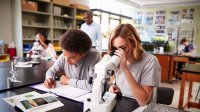Shifting From Linear Learning to a Spiral Approach in Science
Repeated exposure to important concepts helps students retain more information and think deeper about the material they’re studying.
Your content has been saved!
Go to My Saved Content.“What is the difference between alleles and genes again?” said one of my brightest students. The question came only four weeks after my students had seemingly mastered their heredity tests. What did I do wrong as a teacher? Were my resources not comprehensive enough? I used best teaching practices, didn’t I?
Curiously, I wanted to know how quickly students were forgetting the content that they previously had learned. A recurring pattern emerged that after six weeks, a lot of the content that students had learned was no longer retained. This led me to discover the work of Hermann Ebbinghaus, who introduced the concept of the forgetting curve. The human brain is not inherently structured to retain strict, factual information—what teachers often categorize as “level-two knowledge”—such as facts, definitions, and trivial knowledge.
Instead, our brains reason out solutions to problems, recognize patterns, and allow us to be incredibly adaptable learners. This signifies that our minds prioritize certain types of information over others, influenced by their relevance, repetition, and connections that are formed. Recognizing this, I knew I needed to change not only my curriculum and instructional strategies, but also my overall approach of teaching science.
The Benefits of A SpiraL Approach
My quest for improvement led me to buzzwords like spiraling, interleaving, and spacing, teaching me that learning does not have to be linear. Spiraling allows repeated learning of a concept, each time with increased depth. By using a curriculum rooted in inquiry and authentic phenomena, I could spiral scientific concepts, facilitating deeper understandings and connections for my students.
Originally, my approach of teaching mirrored how I was taught in science, which was unit by unit, starting with the scientific method, then cell biology, ecology, and heredity and genetics, and finally ending with evolution. I recognized that “real world” science is not compartmentalized by topic, but all topics are intertwined and connected. Given my past laboratory experience, I knew this to be true, but it did not translate into my first years of teaching. This was a mind shift in my own thinking: to integrate phenomena that drive students to question, investigate, and synthesize multiple scientific concepts during a unit.
Spiraling in Action
I designed a unit that centered around the evolutionary phenomena observed on the Galápagos Islands, interconnecting concepts in ecology, evolution, and genetics, following the Next Generation Science Standards. The unit starts by introducing a catchy video clip that hooks students to be curious and ask questions. I designed the following unit to incorporate real-world scenarios, using authentic data and resources from the Galápagos Islands:
1. Students were given species cards to place on maps of where these animals lived and told to build food webs to show how energy moved throughout the ecosystem.
2. From their food webs, students investigated patterns of interactions among organisms, including mutualism, competition, and predation.
3. Students identified species adaptations that led them to ask, “How do organisms get specific traits?”
4. Students organized their questions into groups based on topics that ranged from traits to adaptations and evolution. Students were led to inquiry-based activities, including looking at DNA strands, to labeling phylogenetic trees based on DNA similarities and differences, and then connecting how DNA plays a big role in understanding how organisms change over time.
5. Labs and data analysis activities led students to answer some of their questions about natural selection and isolation mechanisms.
6. After learning about evolution, students investigated mutations and protein synthesis (structure and function) and how these phenotypes expressed can be advantageous, disadvantageous, or neutral in terms of natural selection.
Deeper Learning
Students were discussing science on a level that was not being done before by connecting how evolution, ecology, genetics, and even organelle structure and function were related to the problems they were solving. Students were gaining a deeper understanding of scientific concepts while honing their modeling, data analysis and interpretation, reading, and writing skills. Students moved on to other units, including the Midwest, Yellowstone, and the American Southwest. These units introduced new content alongside previous content from past units.
After a few spiraling units, a student’s complaint signified a turning point: “Why are we making another food web—we’ve done this twice already!” Students had completed the activity faster than in previous units. This key moment demonstrated that students were genuinely retaining knowledge and skills. The learning in class was no longer a one-and-done process, but students were continually revisiting and refining their understanding of concepts and skills. Not only did I notice an increase in students’ abilities, but English teachers were seeing improvements in students’ writing skills. Over time the rigor increased, and students responded by meeting our expectations, which were higher than ever before.
I felt as if my teaching transformed from the past to the present, enabling students to use phenomena to show mastery of both content and skills at high levels of analysis, literacy, and problem-solving. The future of science teaching is here—allowing students to wonder, be curious, and investigate authentic phenomena while imprinting knowledge that will last.
